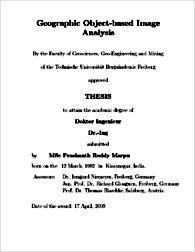| dc.contributor.author | Marpu, Prashanth Reddy | |
| dc.date.accessioned | 2010-10-12T19:27:54Z | |
| dc.date.available | 2010-10-12T19:27:54Z | |
| dc.date.issued | 2009 | |
| dc.identifier.uri | http://hdl.handle.net/11858/00-1735-0000-0001-3181-D | |
| dc.description.abstract | The field of earth observation (EO) has seen tremendous development over recent time owing to the increasing quality of the sensor technology and the increasing number of operational satellites launched by several space organizations and companies around the world. Traditionally, the satellite data is analyzed by only considering the spectral characteristics measured at a pixel. The spatial relations and context were often ignored. With the advent of very high resolution satellite sensors providing a spatial resolution of ≤ 5m, the shortfalls of traditional pixel-based image processing techniques became evident. The need to identify new methods then led to focusing on the so called object-based image analysis (OBIA) methodologies. Unlike the pixel-based methods, the object-based methods which are based on segmenting the image into homogeneous regions use the shape, texture and context associated with the patterns thus providing an improved basis for image analysis ... | |
| dc.format.extent | 135 S. | |
| dc.format.mimetype | application/pdf | |
| dc.language.iso | eng | |
| dc.publisher | Univ. Freiberg (Sachsen) | |
| dc.rights.uri | http://e-docs.geo-leo.de/rights | |
| dc.subject.ddc | 550.28 | |
| dc.subject.gok | TQI 000 | |
| dc.subject.gok | VBJ 000 | |
| dc.title | Geographic object based image analysis | |
| dc.type | monograph | |
| dc.subject.gokverbal | Geophysikalische Satellitenfernerkundung | |
| dc.subject.gokverbal | Satellitenbildgeologie | |
| dc.identifier.doi | 10.23689/fidgeo-249 | |
| dc.identifier.ppn | 606107126 | |
| dc.type.version | publishedVersion | |
| dc.relation.collection | Geophysik | |
| dc.description.type | thesis | |


